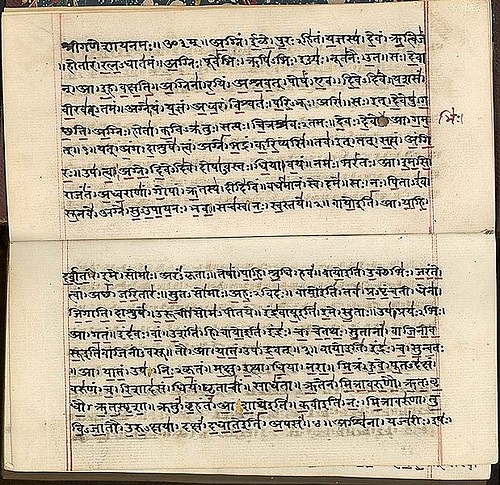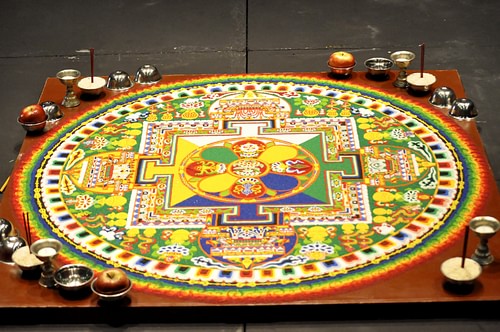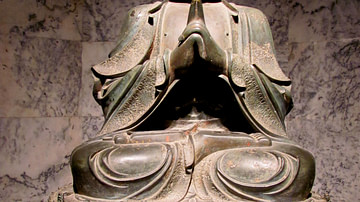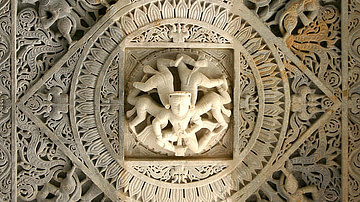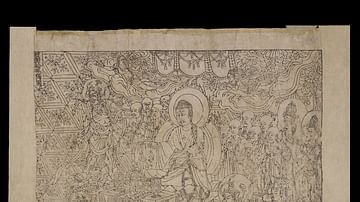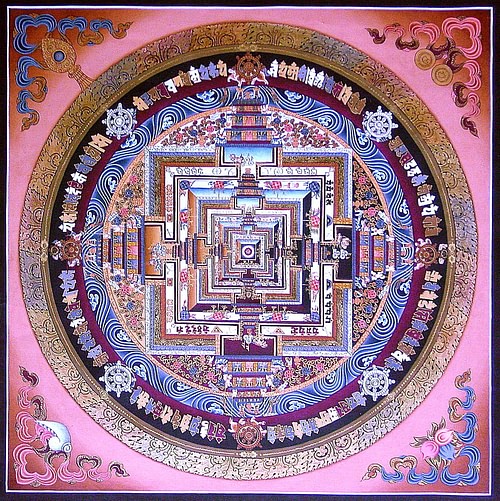
A mandala (Sanskrit for “circle”) is an artistic representation of higher thought and deeper meaning given as a geometric symbol used in spiritual, emotional, or psychological work to focus one's attention. The image first appears in India via the Hindu text known as the Rig Veda c. 1500 - c. 500 BCE.
The image has been used by cultures around the world in many different periods up to the present. The details of the meaning of a given mandala depend on the individual creating or observing the image, but mandalas in every culture serve, more or less, the same purpose of centering an individual or community on a given narrative in order to encourage introspection and, ultimately, an awareness of one's place and purpose in the world; this awareness then allows for peace of mind.
There is no set definition for the meaning or even the form of a mandala, nor could there be, since it appears in the art and architecture – in one form or another – of various cultures around the world. The term and accompanying image first appear in India, as noted, in the Rig Veda where it is also the name of the books which comprise the work but this is simply the image's first appearance in written form, not its last, nor is the Rig Veda thought to be its origin, merely its first expression.
It was, and is, used as a meditative tool and spiritual exercise in the belief systems of Jainism, Buddhism, and Shintoism, appears in Persian art, as the Ishtar Star Symbol (and others) from Mesopotamia, figures in Mesoamerican architecture and Native American art, and was used by the Celts of the Iberian peninsula and Northern Europe, to name only a few cultures that have made use of it in the past or who do so in the present.
The image is usually defined as a circle decorated with imagery which directs the mind of the observer (or creator) inwards from the outer rim toward deeper reflection on the meaning and purpose of life, the nature of the universe, the substance and reality of God, the true nature of the self, the underlying form of reality, cosmological truths, and, actually, any other spiritual, psychological, or emotional aspect of one's life.
Although the circle is the most common form, a mandala may also be a square enclosing a circle or a series of circles, a square alone, a circle enclosing an image (such as a star or flower), and a rectangle enclosing a circle. Mandalas are defined in many different ways, however, and are not limited to any of these geometric shapes exclusively. The best example of this is the Celtic Cross which is considered by some scholars a mandala.
In the modern day, the most extensive, groundbreaking work on the meaning and purpose of the mandala was pioneered by the iconic Swiss psychiatrist Carl Gustav Jung (l. 1875-1961) who devotes considerable time to the subject in a number of his works.
To Jung, the mandala was the key to self-understanding and self-acceptance; by creating mandalas, one could come to know one's self more completely, recognize unhealthy thoughts and behaviors, and move closer to the center of one's actual being, leaving behind the various illusions of the self which clouded and confined one's psychological and spiritual vision.
Jung's work opened up the possibility for the secular uses of the mandala – though he consistently emphasized its spiritual power and use – and popularized the image in the West. In the present day, mandalas appear in significant numbers around the world in both religious and secular contexts and have gained a significant following among those who use the image to manage stress.
Mandala in Hinduism
Whatever else the mandala may represent to an individual, it essentially reflects order – whether of the cosmos, nation, community, or self – but is understood as an almost self-created image of that order. The person who draws the mandala in paint or chalk or creates it with colored sand or yarn or any other material, is thought to be generating the image from some higher source. This source does not necessarily have to be a supernatural entity of any kind (it could be one's higher self) but, in the beginning, it definitely was.
Hinduism is known by adherents as Sanatan Dharma (“Eternal Order”), and the order it references was established by an all-powerful supernatural entity, too overwhelming for the human mind to comprehend, who created, maintained, and also was the Universe. At some point in the ancient past, Brahman “spoke” the eternal truths of existence which were “heard” by sages of India while in a deep, meditative state. This knowledge came to be regarded as shruti (“what is heard”) and retained in oral form until it was set down in writing as the Vedas during the Vedic Period (c. 1500 - c. 500 BCE), with the Rig Veda thought to have been written first.
The Rig Veda is comprised of ten books, known as mandalas, containing 1,028 hymns of 10,600 verses relating to religious understanding and practice. Since Brahman was understood as beyond human comprehension, it was thought that the entity appeared to people as avatars – forms and aspects of itself – through which one could connect with the source of all life.
In time, this ideology developed the concept of a higher self within each individual known as the Atman which was a divine spark of Brahman linking one to all other living things and to the Universe itself. The purpose of life was to attain oneness with the Atman through adherence to one's duty (dharma) performed with the right action (karma) in order to liberate one's self from the cycle of rebirth and death (samsara) and achieve liberation (moksha).
The Rig Veda provided guidance toward this liberation through its mandalas which encouraged an audience to question perceived reality, reject illusion, and pursue true knowledge and wisdom concerning the self and the world. Each book of the Rig Veda is, in fact, a mandala as it leads one from the outer rim of understanding toward the center of meaning.
The images which came to accompany the text – and which are the oldest mandalas in the world – served as illustrations of the truth of the vision as received by Brahman. This work established the basic use of the image of the mandala which has continued up through the present: a kind of self-teaching tool to elevate the mind from the mundane to the sublime.
The Nastika Schools
Toward the end of the Vedic Period, c. 600 BCE, there was a spiritual and cultural shift in India which encouraged various thinkers to question the Hindu vision. The Vedas were written, and recited, in Sanskrit by the priests – a language the people could not understand – and so were also interpreted by the clergy for the people.
Objections to this practice encouraged questions concerning the validity of the entire belief system and so a number of philosophical schools arose which either supported the orthodox Hindu view or rejected it. Those schools who supported it were known as astika (“there exists”), and those who rejected Hindu thought were known as nastika (“there does not exist”). The best known nastika schools were Charvaka, Jainism, and Buddhism, all three of which came to use the mandala in their own systems.
Charvaka: The Charvaka mandala represents the central belief of the school that only perceivable reality of the four elements of air, earth, fire, and water exists. Charvaka was founded by the reformer Brhaspati (l. c. 600 BCE) who completely rejected any supernatural concepts and insisted on direct, personal experience as the only means of establishing truth.
The Charvakan mandala reflects this as an image of the four elements each enclosed in a circle within a broader circle. The mandala, in this case, would have encouraged one's belief in materialism and the materialistic truth of the human condition and prevented the mind from wandering to speculative thought on higher powers or any other meaning in life other than pursuing one's own pleasure and recognizing the observable world as the only reality.
Jainism: Jainism was expounded by the sage Vardhamana (better known as Mahavira, l. c. 599-527 BCE). Although often referenced as Jainism's founder, he is known by adherents as the 24th tirthankara (“ford builder”), one in a long line of enlightened souls who recognized the illusory nature of existence and freed themselves (and then others) through adherence to a strict spiritual discipline which broke the cycle of samsara and led to liberation.
Jains observe this same discipline in the hope of reaching the same goal. Jain mandalas illustrate this path and discipline through images of Mahavira (or an earlier tirthankara) in the center of a circle enclosed by ever-widening squares in which representations of various divine spirits (devas) or life-conditions appear. The details of a Jain mandala vary but, frequently, Mahavira appears in the center and the observer is invited to travel the image from the outer rim of distraction and illusion toward the central truth revealed by Mahavira. An observer, in the stillness of contemplation, is thereby provided with a kind of spiritual map of the Jain path.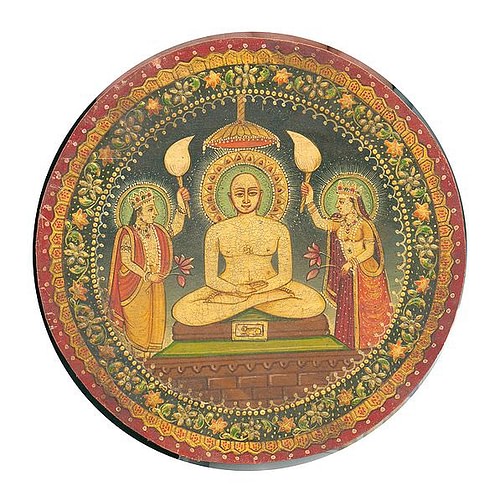
Buddhism: Buddhism was founded by Siddhartha Gautama (the Buddha, l. c. 563 - c. 483 BCE) who recognized that people suffered in life by insisting on permanent states of being in a world of constant change. After his enlightenment, he taught a spiritual discipline which encouraged detachment from craving for permanence and fear of loss as well as shedding one's ignorance of the true nature of existence which trapped the soul in the unending suffering of samsara. His Four Noble Truths and Eightfold Path, he taught, would lead one to the liberation of nirvana.
His illustration of the cycle of samsara, The Wheel of Becoming, is a mandala which illustrates how the soul suffers through ignorance, craving, and fear and his teachings show one how to escape from the cycle of the wheel. The Buddhist mandalas are as varied as any other school of thought but provide one with a visual representation of the Buddhist vision. This vision can take many forms, from Buddha appearing at the center to a depiction of Buddhist cosmology, an illustration of one's progress along the Eightfold Path, or the story of Buddha's journey from illusion to enlightenment. Buddhists sometimes create a mandala from colored sand, carefully crafting the piece, only to then wipe it away in recognition of the impermanence of all things.
All three of these schools used the mandala to reinforce their visions of the nature of life and one's place in it but, in time - or perhaps even from the very start - the mandala developed a life and power of its own through which, it is said, the act of creating the image directed the person doing so in the story it told and the truth it revealed. One was not, in other words, creating an image consciously the way one would draw a picture but was 'receiving' the image from some deeper or higher source.
Jung & the Mandala
Carl Jung was the first to explore this aspect of the mandala in the West and popularized its usage. In his autobiography Memories, Dreams, Reflections, he describes his early experience with the mandala c. 1918-1919:
It was only toward the end of the First World War that I gradually began to emerge from the darkness…I sketched every morning in a notebook a small circular drawing, a mandala, which seemed to correspond to my inner situation at the time. With the help of these drawings, I could observe my psychic transformations from day to day…Only gradually did I discover what the mandala really is: “Formation, Transformation, Eternal Mind's eternal recreation”. And that is the self, the wholeness of the personality, which if all goes well is harmonious, but which cannot tolerate self-deceptions. My mandalas were cryptograms concerning the state of the self which were presented to me anew each day…When I began drawing the mandalas, I saw that everything, all the paths I had been following, all the steps I had taken, were leading back to a single point, namely, to the mid-point. It became increasingly plain to me that the mandala is the center. It is the exponent of all paths. It is the path to the center, to individuation. (195-196)
The concepts Jung expresses here are, essentially, the same as those presented by the mandalas of the Rig Veda and those of the later nastika schools. The mandala, whatever form it takes, encourages the individual to explore the nature of the self in relation to the self, to others, to circumstances, and to the wider world of experience. Whether one is focusing on an image of the Hindu deity Ganesha (remover of obstacles) at the center of a mandala, an image of the elements, Mahavira, Buddha, or a lotus flower, one is encouraged to reflect upon one's path in life, the choices one has made and their consequences, and what one might do differently or the same.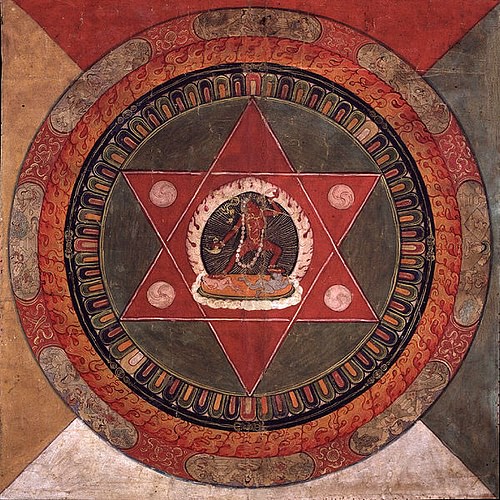
It is hardly surprising that Jung should express the same concepts as the ancient belief systems of India, first, because he was well-versed in them but also because of his belief in what he called the Collective Unconscious, a broad body of universal knowledge shared, at an unconscious level, by all members of a species. Jung cited this Collective Unconscious to explain, for example, why the pyramid shape appears in so many ancient cultures which had no contact, why certain archetypes such as the Wise Sage, the Trickster, the Tree of Life, the Great Mother, the Shadow appear in the art, literature, scripture, and architecture of ancient cultures, independent of each other, the world over. In the same way, Jung felt, the mandala was an archetype which the individual responded to naturally because, at some deep level, the observer already recognized the image as a potent symbol of transformation and change, of a recognition of established order and one's place in it.
Conclusion
No matter how seemingly different the varied cultures of the world may be, the mandala appears – in one form or another – in virtually all of them. Jung defines it as “an instrument of contemplation” (Archetypes, 356) and notes the universal spiritual and psychological importance of moving from the outside – the external world – toward the center – the self – in order to achieve full individuation, in order to recognize, and become, the self. The externals depicted on the outside of the mandala are parts of that self, just as all the others drawing the observer toward the center are, but it is toward that center that one's attention is drawn, and toward which one naturally moves. Jung writes:
The energy of the central point is manifested in the almost irresistible compulsion and urge to become what one is, just as every organism is driven to assume the form that is characteristic of its nature, no matter what the circumstances. This center is not felt or thought of as the ego but, if one may so express it, as the self. (Archetypes, 357)
The mandala has appeared on the covers of the Torah and Tanakh, is regularly seen in depictions of Christian saints with a halo of light surrounding their heads and in other Christian iconography, decorates the covers of the Quran and elevates the mind as the colorful and intricate design of the ceilings of mosques. Native Americans of the north and south regions used the mandala, whether as direct representations of a deity or the cosmos or to symbolize a spiritual journey, state of mind, or to ward off bad spirits as with the circular hoop design known as a dreamcatcher.
Mandalas of the Shinto religion of Japan follow the same paradigm, and mandalas also appear in Greek works and designs, notably those featuring the “evil eye”, which deflect bad luck and curses. The ancient Celts made use of the circle within a circle, decorated with various designs, which corresponds to the mandala, as did the ancient Mesopotamians in symbols of their deities. The soapstone seals of the people of the Indus Valley Civilization, thought to correspond in usage to the Mesopotamian cylinder seals, can also be understood as a kind of mandala in that they depict a central image, toward which one's attention is drawn, accompanied by symbols enclosed in a circle.
The mandala has been a part of the human experience for thousands of years, but ever since the popularization of the works of Jung in the 1960's and, more so, after the widespread popularity of the work of the scholar Joseph Campbell (whose theories are informed by Jung) in the 1970's-1980's, the significance of the image has been recognized far more fully in the West. Spiritual centers, yoga classes, grief therapy counselors, and many more institutions and professional occupations utilize the mandala in helping their clientele.
Mandala coloring books for adults are bestsellers, recognized for their efficacy in reducing stress, and mandalas appear more and more frequently as posters or paintings in offices for the same reason. Whether one responds to the mandala on the wall as one walks into, say, a dentist's office, is entirely up to the individual; but the image is there to encourage one to remain calm, recognize there is an established order, and that all one need do is focus on the center to find one's peace.
